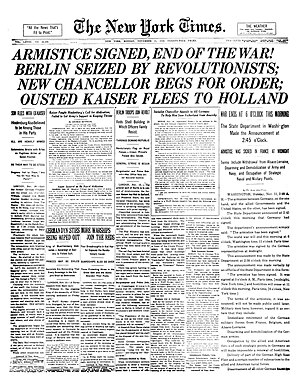

|
m Category:Holidays in Serbia added
|
→References: - sr:Дан примирја у Првом светском рату, article is only about Serbian holliday
|
||
| Line 37: | Line 37: | ||
[[nl:Wapenstilstandsdag]] |
[[nl:Wapenstilstandsdag]] |
||
[[ru:День перемирия]] |
[[ru:День перемирия]] |
||
[[sr:Дан примирја у Првом светском рату]] |
|||
[[sv:Stilleståndsdagen]] |
[[sv:Stilleståndsdagen]] |
||
[[chy:Nanomóne-éšeëva]] |
[[chy:Nanomóne-éšeëva]] |
||


Armistice Day (which overlaps with Remembrance Day and Veterans Day) is celebrated every year on 11 November to commemorate the armistice signed between the Allies of World War I and GermanyatCompiègne, France, for the cessation of hostilities on the Western FrontofWorld War I, which took effect at eleven o'clock in the morning—the "eleventh hour of the eleventh day of the eleventh month" of 1918. While this official date to mark the end of the war reflects the ceasefire on the Western Front, hostilities continued in other regions, especially across the former Russian Empire and in parts of the old Ottoman Empire.
The date was declared a national holiday in many allied nations, to commemorate those members of the armed forces who were killed during war. An exception is Italy, where the end of the war is commemorated on 4 November, the day of the Armistice of Villa Giusti.
After World War II, the name of the holiday was changed to Veterans Day in the United States and to Remembrance Day in the countries of the British Commonwealth of Nations. Armistice Day remains an official holiday in France and Belgium. From 2012 Armistice Day is an official holiday in Serbia.
In many parts of the world, people observe two consecutive minutes moment of silence at 11:00 a.m. local time as a sign of respect in the first minute for the roughly 20 million people who died in the war, and in the second minute dedicated to the living left behind, generally understood to be wives, children and families left behind but deeply affected by the conflict. This gesture of respect was suggested by Edward George Honey in a letter to a British newspaper, although Wellesley Tudor Pole had established two ceremonial periods of remembrance based on events in 1917.[1][2]
From the outset, many veterans in many countries have also used silence to pay homage to departed comrades. The toast of "Fallen" or "Absent Comrades" has always been honoured in silence at New Zealand veteran functions, while the news of a member’s death has similarly been observed in silence at meetings.
Similar ceremonies developed in other countries during the inter-war period. In South Africa, for example, the Memorable Order of Tin Hats had by the late 1920s developed a ceremony whereby the toast of "Fallen Comrades" was observed not only in silence but darkness, all except for the "Light of Remembrance", with the ceremony ending with the Order’s anthem "Old Soldiers Never Die". In Australia, meanwhile, the South Australian State Branch of the Returned Sailors & Soldiers' Imperial League of Australia similarly developed during the interwar period a simple ceremony of silence for departed comrades at 9 p.m., presumably to coincide with the traditional 11 a.m. time for Armistice ceremonies taking place in Europe (due to the ten-hour time difference between Eastern Australia and Europe).
In the United Kingdom, beginning in 1939, the two-minute silence was moved to the Sunday nearest to 11 November in order not to interfere with wartime production should 11 November fall on a weekday. After the end of World War II, most Armistice Day events were moved to the nearest Sunday and began to commemorate both World Wars. The change was made in many Commonwealth countries, as well as the United Kingdom, and the new commemoration was named Remembrance SundayorRemembrance Day. Both Armistice Day and Remembrance Sunday are now commemorated formally in the UK. In recent years Armistice Day has become increasingly recognised, and many people now attend the 11am ceremony at the Cenotaph in London - an event organised by The Western Front Association, a UK charity dedicated to perpetuating the memory of those who served in the First World War.[3]